Indiana, part of the Midwest, is the “breadbasket of America.” This state is renowned for its rich farmland and rolling landscapes, but it is also home to a splendid array of native trees that have graced its terrain for centuries. These trees play a significant role in the state’s ecosystem and hold historical and cultural importance for Hoosiers.
From shading backyards to adorning city parks, Indiana’s iconic trees stand as silent witnesses to the changing seasons and history of the state. Join us as we journey through the Hoosier state, uncovering the most iconic native trees that, over time, become symbols of Indiana’s rich natural beauty.
What Trees Are Native to Indiana?
Indiana’s 4.5 million forested acres, covering 20% of its land, are home to over 100 native tree species. These trees, like the American plum and basswood, play pivotal roles in the local ecosystem, providing beauty, shelter, and supporting pollination.
The state’s predominant forest types are oak-hickory and maple-beech. Indiana takes pride in its one National Forest and 33 state parks and forests, preserving its rich biodiversity. However, the state remains vigilant against 37 invasive tree species that threaten its natural heritage. Still, the state has a fair share of native tree species. Here, we will cover 23 of the most iconic native trees in Indiana.
1. American Plum (Prunus americana)

One of the most beautiful fruit-bearing trees in Indiana is the American plum tree.
©Oleg Rebrik/iStock via Getty Images
The American plum tree is a beautiful tree, especially when it’s in full bloom. Either appearing as a small tree or a sizable shrub with multiple stems, it showcases a sprawling crown adorned with slightly serrated, oval leaves measuring about 3-4 inches.
In summer, these leaves sport a rich green hue, but as autumn approaches, they transform into stunning shades of fiery red and soft yellow. In spring, the tree bursts into a spectacular display of aromatic white flowers, which cluster together, covering the otherwise bare branches.
The American plum thrives best when exposed to ample sunlight, though it doesn’t mind a bit of shade. Ensure the soil is moderately moist and well-draining.
2. Bald Cypress (Taxodium distichum)

Cyprus trees are unique and have extremely wide bases and extensive root systems that can grow directly into water.
©Marianne Pfeil/iStock via Getty Images
The bald cypress is an Indiana-native tree that starts its life out with a slim pyramid shape. However, as it grows older, it expands, forming a wide, open crown.
Its needle-like leaves are vibrant green during the warmer months. But as autumn rolls in, they transform into a striking shade of golden yellow before falling off. Even in winter, when its leaves are gone, the tree doesn’t lose its charm, thanks to its reddish-gray bark that has a unique peeling texture.
While the bald cypress is adaptable to typical garden soils, it truly shines in wetter areas where many standard trees struggle to grow.
3. American Basswood (Tilia americana)

The flowers of the American basswood are a sight to behold in early summer in Indiana.
©Alina Vaska/Shutterstock.com
The American basswood is another native tree in Indiana. With a rounded crown of expansive dark green leaves that can reach lengths of up to 6 inches, this tree presents a serene display, especially when the leaves take on a subtle yellow-green hue during fall.
By early summer, this tree delights onlookers with its blossoms of soft, creamy-yellow flowers that look beautiful and emit a sweet fragrance.
The American basswood thrives best in areas with abundant sunlight but can also manage in partial shade. It’s not particularly picky about soil – it loves moist, nutrient-rich grounds and is adaptable enough to grow in drier or clay-heavy soils too.
4. Black Cherry (Prunus serotina)
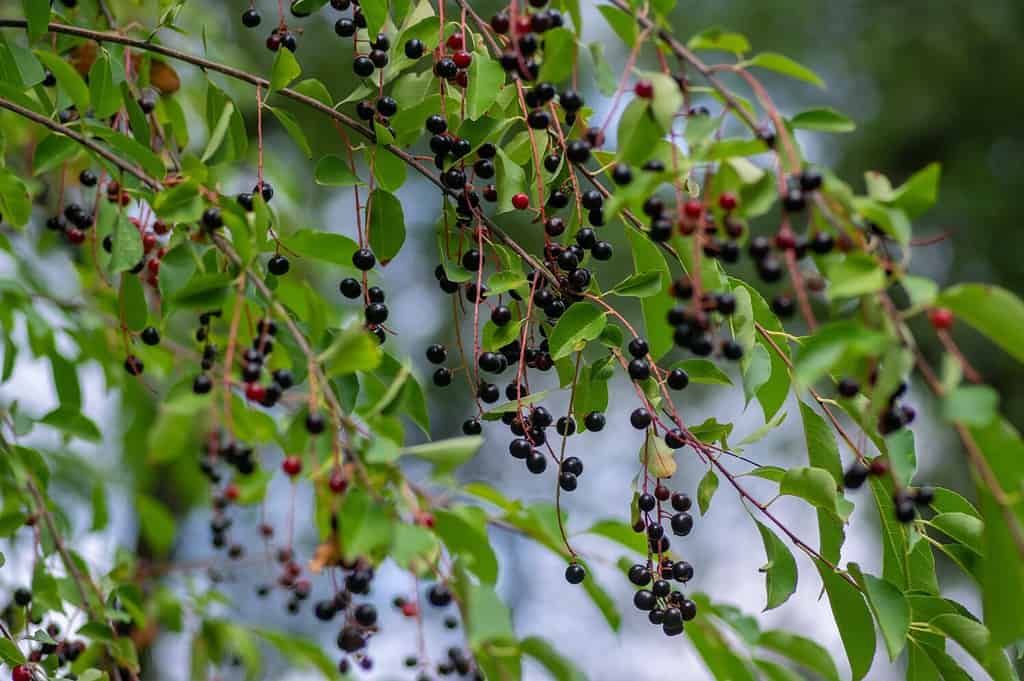
Another beautiful fruit tree that is native to Indiana is the black cherry tree.
©Iva Vagnerova/Shutterstock.com
The black cherry starts as a pyramid-shaped tree in its early years, but as it matures, it takes on a more rounded appearance with wide, sweeping branches. Its branches are decorated with long, shiny green leaves that have a delicate serrated edge, measuring up to 5 inches.
As autumn approaches, these leaves take on vivid hues of yellow and red, creating a stunning display. Between spring and early summer, this tree puts on a show with clusters of sweet-scented white flowers that hang elegantly, often shortly after the leaves make their debut.
For the most vibrant blooms and fruits, placing the black cherry in a spot bathed in sunlight is ideal. While it can handle periods of dryness, this tree truly flourishes in nutrient-dense, moist soil.
5. Black Gum (Nyssa sylvatica)
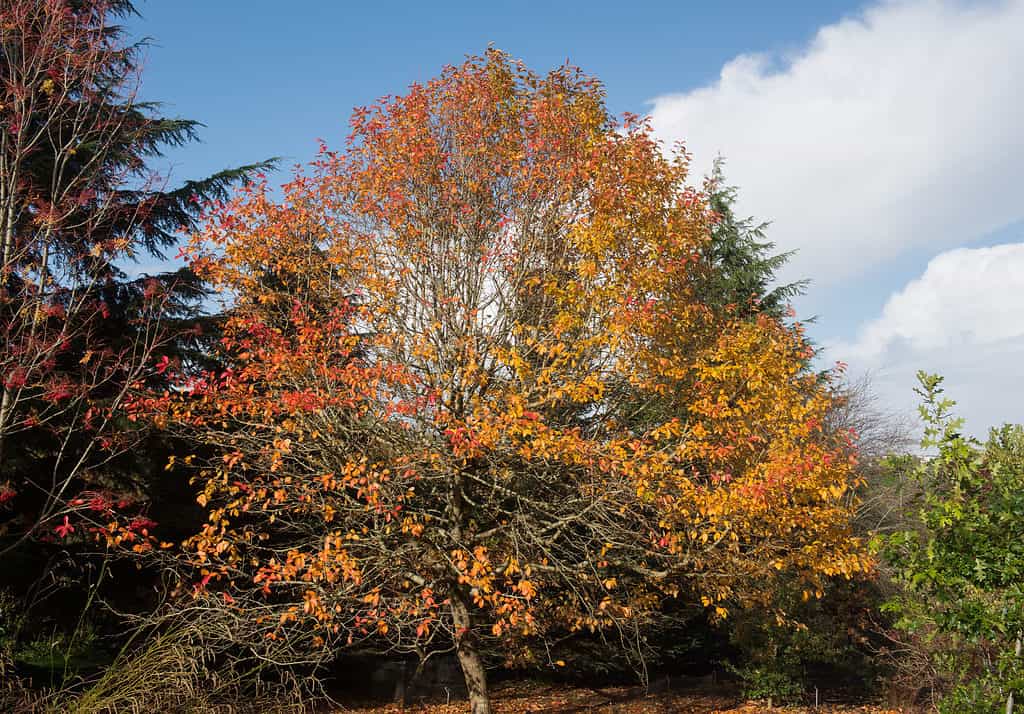
In fall, the black gum tree has a beautiful display of colorful leaves.
©Peter Turner Photography/Shutterstock.com
The black gum tree is a wonderful Indiana native for those seeking ornamental shade, especially when autumn arrives. This deciduous tree grows slowly, eventually forming a dense, pyramid-like structure. Its straight trunk typically supports numerous thin branches stretching horizontally, creating an elegant, wide cone shape.
Interestingly, not all black gums look the same; some might surprise you with a flatter canopy. When spring graces the land, this tree offers modest, greenish-white flower clusters that bloom atop lengthy stems.
Ideally, the black gum prefers a spot with plenty of sunlight but can also thrive in partial shade. It’s not fussy about soil conditions, growing well in moderate to wet, well-draining soils.
6. Black Locust (Robinia pseudoacacia)
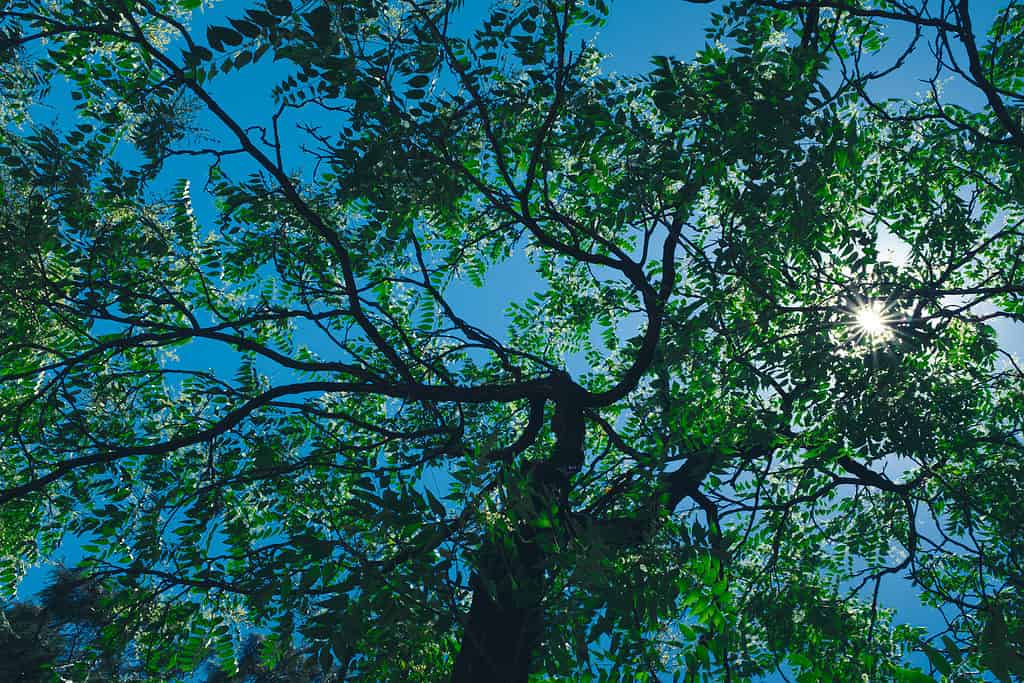
One of the most iconic large trees native to Indiana is the black locust.
©iStock.com/Ye Zhang
The black locust is a rapidly growing tree known for its appealing compound leaves and drooping clusters of fragrant, pea-like blooms. Its leaves, which feature a combination of 5-11 paired oval leaflets, wear a dark blue-green hue. Come autumn, they shift to a bright yellow before eventually falling.
As the leaves depart, they unveil the tree’s striking, deeply textured bark. By late spring and early summer, the tree is adorned with cascading white flower clusters, each stretching up to 8 inches.
For optimal growth, the black locust prefers sunny spots and flourishes in soil that’s either dry or moderately moist as long as it’s well-draining.
7. Black Oak (Quercus velutina)
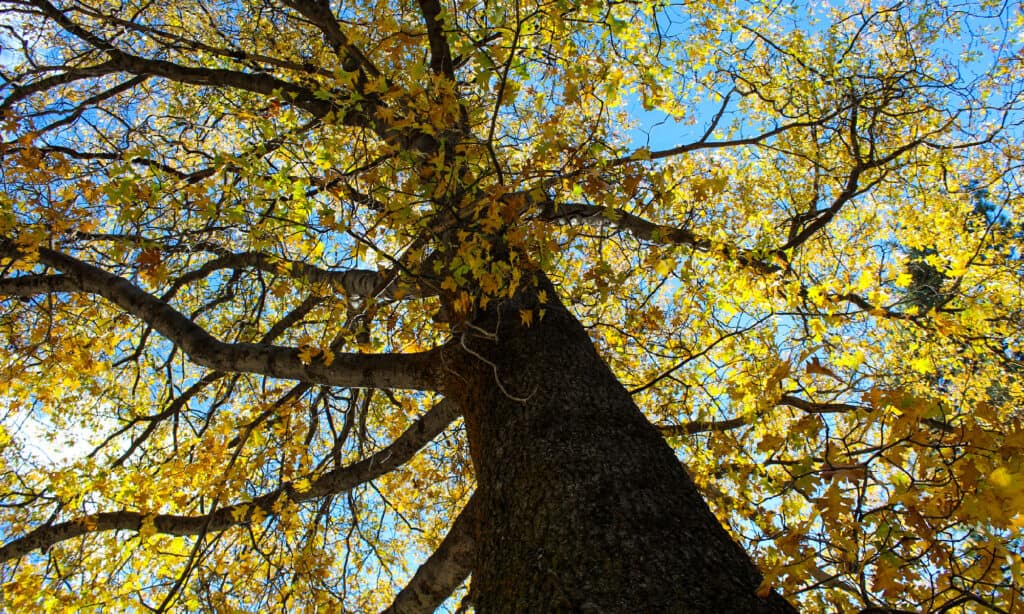
A large sturdy tree that can grow to nearly 60 feet, the black oak is a wonderful tree in Indiana.
©iStock.com/Jared Quentin
The black oak is a medium to large tree crowned by a uniquely rounded canopy. Its sizeable leaves, reaching up to 10 inches in length, are distinguished by their 7-9 deep lobes.
These leaves, dark green on the top and lighter beneath, transform into radiant hues of yellow, orange, or brown as autumn approaches.
For the black oak to truly thrive, it seeks out sunny locations and prefers soil that’s both deep and fertile, ranging from dry to moderately moist and well-draining. While its ideal setting is on moist, nutrient-rich soil, it’s not uncommon to find this hardy tree on less favorable sandy terrains or dense clay slopes.
Fun fact: Black Oak trees often live over 200 years, so if you plant one in your yard, it may be in your family for generations!
8. Black Walnut (Juglans nigra)
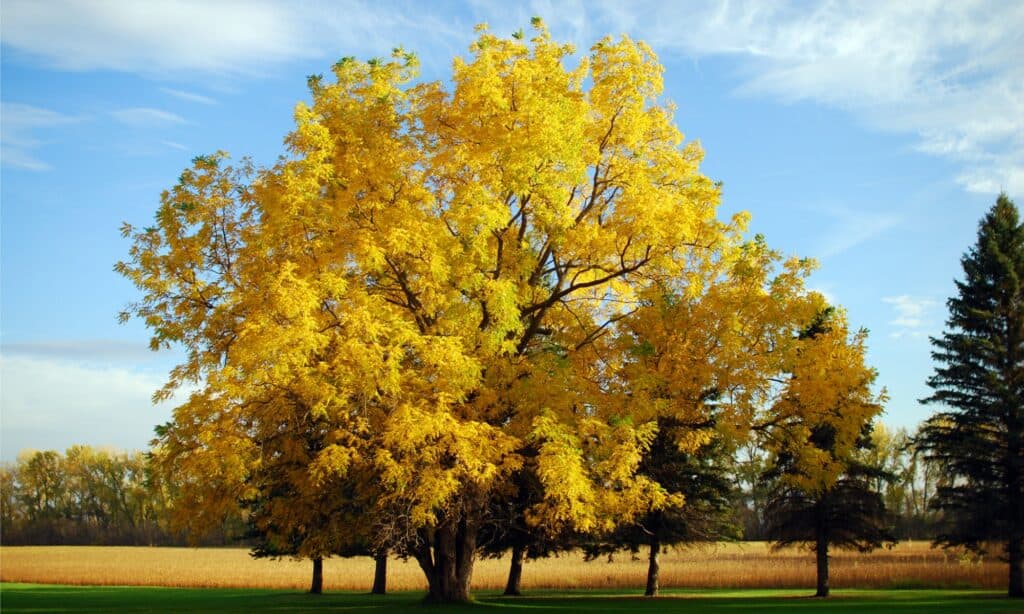
If you are looking for a large tree to plant that also bears delicious nuts, a black walnut tree is a perfect choice!
©iStock.com/jdt01fgo
The black walnut is a towering tree boasting a broad canopy shaped between an oval and a circle, supported by expansive branches. The tree’s large compound leaves, stretching up to 24 inches, consist of 15-21 slender leaflets. When these leaves are crumpled, they release a distinct aroma.
These dark green leaves make a late appearance in spring, and by autumn, they shift to a vibrant yellow before dropping. Every spring, the tree also unveils subtle greenish-yellow blossoms.
For the black walnut to reach its full potential, it prefers sunny spots and thrives in soil that’s both moist and rich in organic matter, ensuring proper drainage.
9. Eastern Red Cedar (Juniperus virginiana)
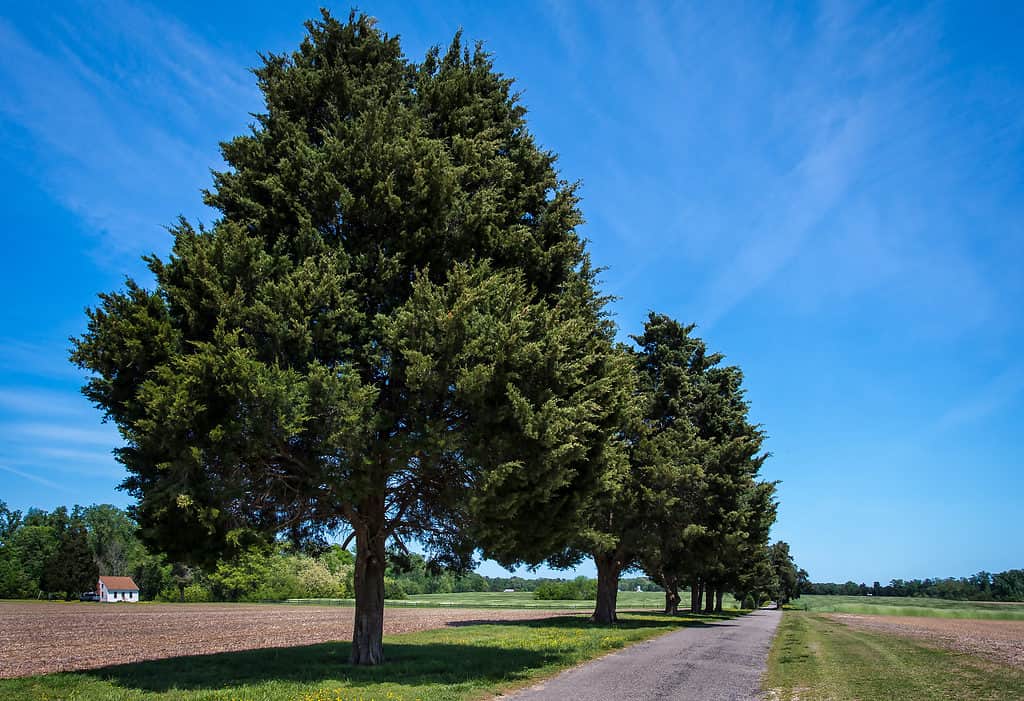
A popular native tree in the Midwest is the eastern red cedar, which is evergreen and grows very easily.
©Gerry Bishop/Shutterstock.com
The eastern red cedar stands out as the most common native conifer across the eastern part of North America. This evergreen tree has a shape that ranges from a tight column to a broad pyramid, making it a striking feature in any landscape. Its aromatic, scale-like leaves come in various shades, from a grayish-green to deep green, and even some with a bluish tint.
Because it retains its leaves throughout the year, many of Indiana’s birds find the eastern red cedar to be a cozy place to nest and rest.
This tree thrives in sunny locations and isn’t too picky about its soil, growing happily in a range from dry to moderately moist grounds as long as they drain well.
10. Green Ash (Fraxinus pennsylvanica)
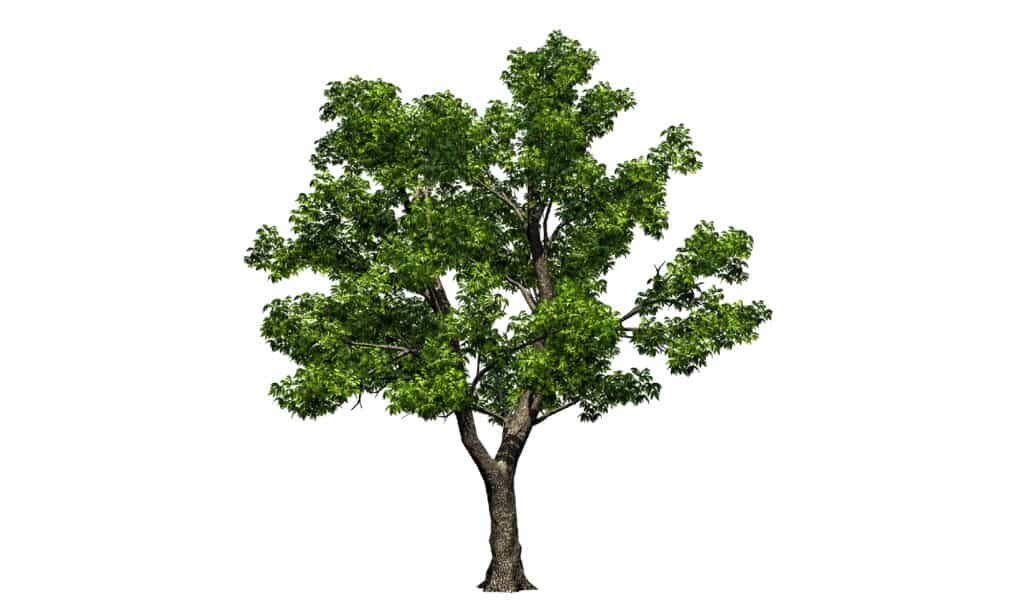
Ash trees are one of the most common tree species in the United States.
©iStock.com/bestofgreenscreen
Another native tree in Indiana is the green ash, a magnificent medium-sized deciduous tree. In its youth, it sports a pyramidal shape, which gracefully matures into a rounded canopy atop a straight trunk.
Its leaves are a fresh medium green, made up of 5-9 leaflets, and by autumn, they transform into a stunning golden yellow.
This tree finds its comfort in sunny spots and thrives best in soil that’s fertile, moist, and offers good drainage.
11. Kentucky Coffeetree (Gymnocladus dioicus)

An impressive tree in Indiana is the Kentucky coffeetree.
©nickkurzenko/iStock via Getty Images
The Kentucky coffeetree is characterized by its slow growth rate. This deciduous tree has a stout trunk, topped with a slim, open canopy that showcases its impressive leaves.
When the leaves first appear in the late spring, they sport a pinkish hue. As summer progresses, they adopt a deep blue-green color, eventually shifting to delicate shades of gold and yellow come autumn.
Preferring sunlit spots, this Indiana native tree flourishes in soil that’s both moist and rich in organic matter, ensuring it drains well.
12. Yellow Buckeye (Aesculus flava)
The yellow buckeye is a grand deciduous tree with an upright to rounded structure. Its massive branches are scattered with leaves that split into 5-7 dark green sections.
From mid to late spring, it sprouts subtle greenish-yellow blooms in upright clusters, though they can sometimes be overshadowed by the surrounding foliage.
This tree does best in soils that maintain moderate moisture and drain well, whether under the full glare of the sun or in partially shaded areas.
13. Smooth Alder (Alnus serrulata)
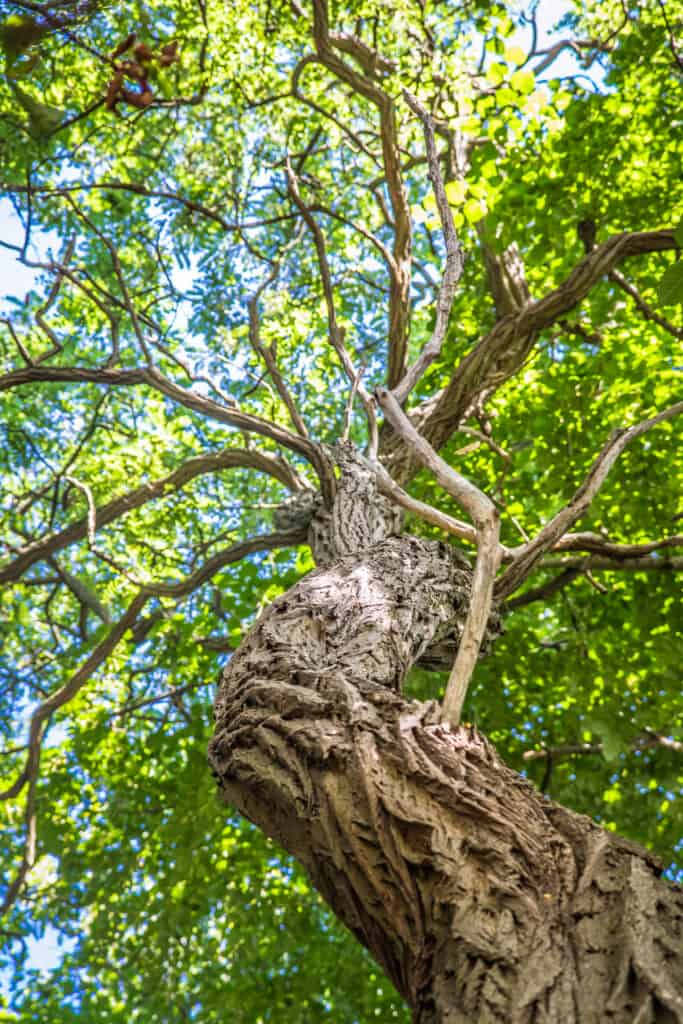
There are many different varieties of alder trees. The smooth alder is a common native tree found in the American Midwest.
©Aleksandra Duda/Shutterstock.com
The smooth alder is a strikingly appealing tree native to Indiana.
Its leaves are wavy, shaped somewhere between elliptical and oval, boasting a shiny green hue. These leaves, measuring between 2-4 inches, transition to a yellow-brown shade when autumn arrives. By early spring, slender pale yellow strands, reminiscent of festive ornaments, hang gracefully near the ends of its bare branches.
This plant prefers sunny spots and thrives in soil that ranges from moist to slightly wet.
14. American Larch (Larix laricina)
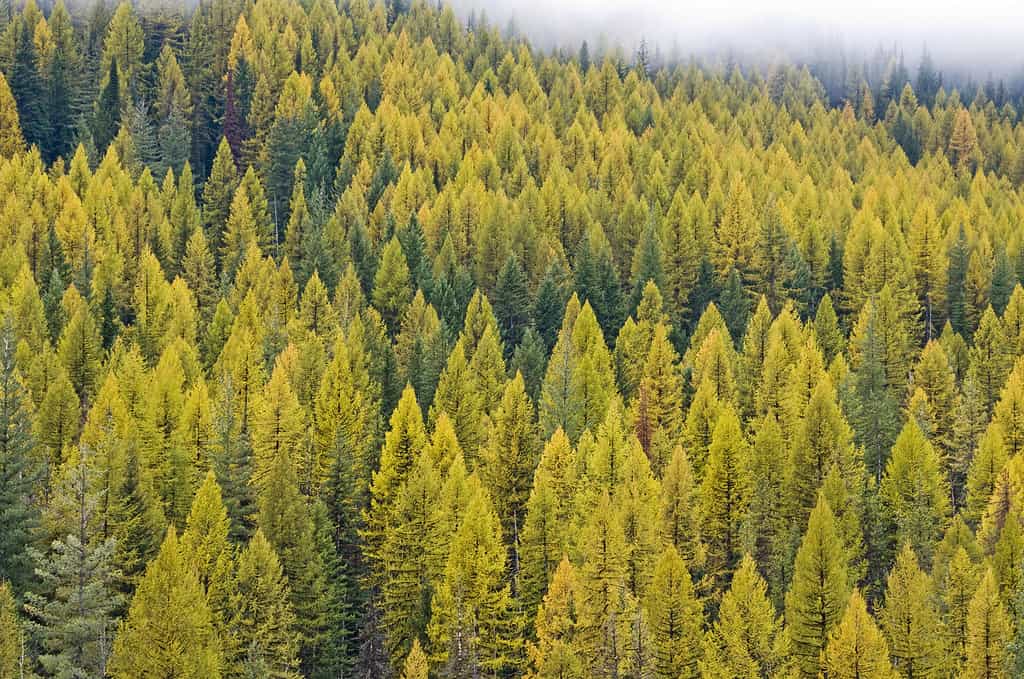
After turning yellow, the American larch sheds its leaves.
©PhilAugustavo/iStock via Getty Images
The American larch is a unique, medium-sized deciduous conifer known for its elegance. It presents an upright shape with branches that stretch out horizontally or slightly upwards.
Distinctly different from most conifers, the American larch sheds its leaves during winter. Its gentle blue-green needles adopt a vivid yellow hue before dropping in autumn.
This tree prefers bright sunlight and thrives in damp, acidic soils that drain well. In Indiana, you’ll typically find it in marshy areas and along the moist shores of lakes and streams.
15. Tulip Tree (Liriodendron tulipifera)
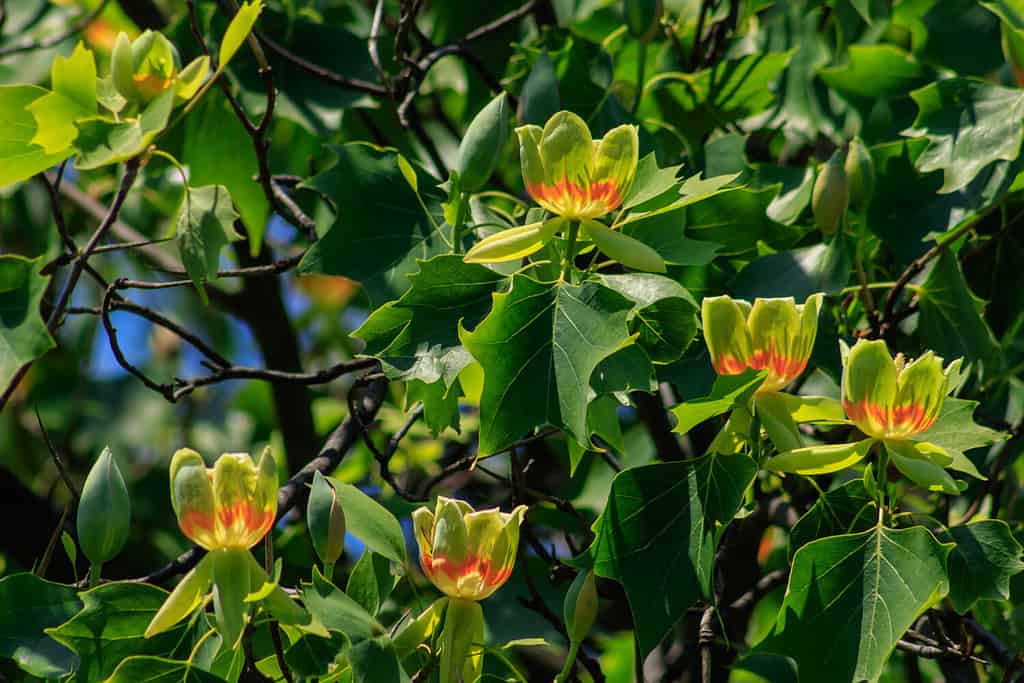
Tulip trees are the official state tree of Indiana and can live over 350 years!
©Yanosh Nemesh/Shutterstock.com
No native tree is as iconic to Indiana as the official state tree, the tulip tree. When young, it boasts a pyramid-like shape, maturing into a broad, rounded silhouette.
During the transition from spring to summer, mature trees, typically those 12-15 years or older, showcase unique greenish-yellow flowers resembling tulips. These blossoms have a touch of orange at the base of every petal.
Tulip trees are very long-living. In fact, the oldest tulip tree in the USA is estimated to be more than 350 years old!
This tree flourishes best in sunlit areas and prefers soil that’s both rich in organic matter and well-draining with a slightly acidic touch.
16. Eastern Cottonwood (Populus deltoides)
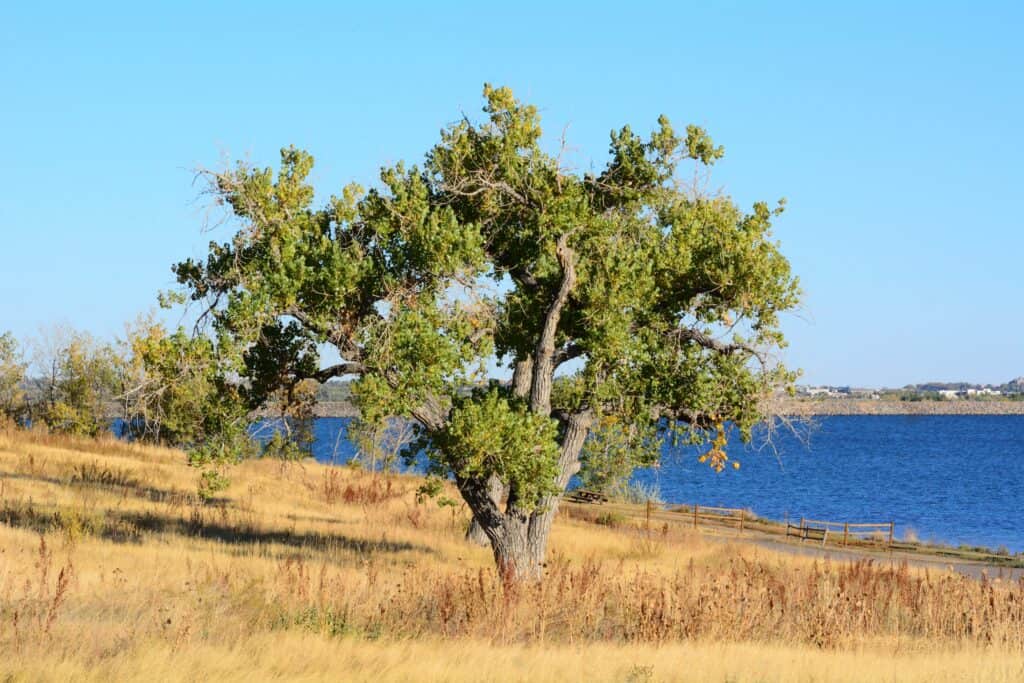
The eastern cottonwood tree can grow to over 100 feet!
©Merrimon Crawford/Shutterstock.com
Among Indiana’s forest giants, eastern cottonwood is one of the largest. This deciduous tree grows rapidly and features a tall, vase-like shape. Eastern cottonwoods can grow to over 100 feet tall and may grow as much as 8 feet per year in the right conditions! Its leaves, dark green and shiny, can span up to 5 inches and tend to have a golden color as autumn approaches.
The bark on older trees showcases a distinctive ash-gray color characterized by broad, flattened patterns separated by deep grooves.
This tree performs when bathed in sunlight and prefers soil conditions that are moderately moist to slightly wet but always well-draining.
17. American Aspen (Populus tremuloides)
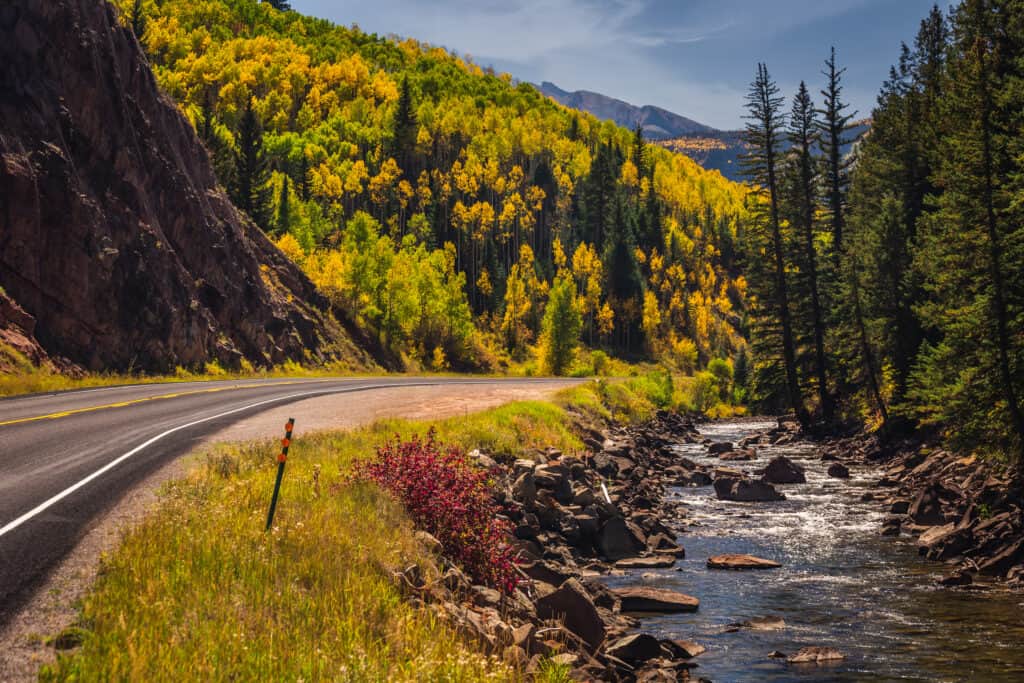
An iconic tree, the American aspen is a pyramid-shaped tree.
©iStock.com/RuslanKaln
The American aspen is an iconic native tree to Indiana. This medium-sized tree with a gentle pyramid shape, topped by a rounded canopy. Its leaves, which have a shimmering dark green hue and delicate serrated edges, can reach up to 3 inches in length. As autumn graces Indiana, these leaves transform into a striking gold.
This tree is predominantly spotted in Indiana’s northern regions.
Thriving under full sun, the American aspen prefers nutrient-rich, moist soils that still provide good drainage.
18. Bur Oak (Quercus macrocarpa)
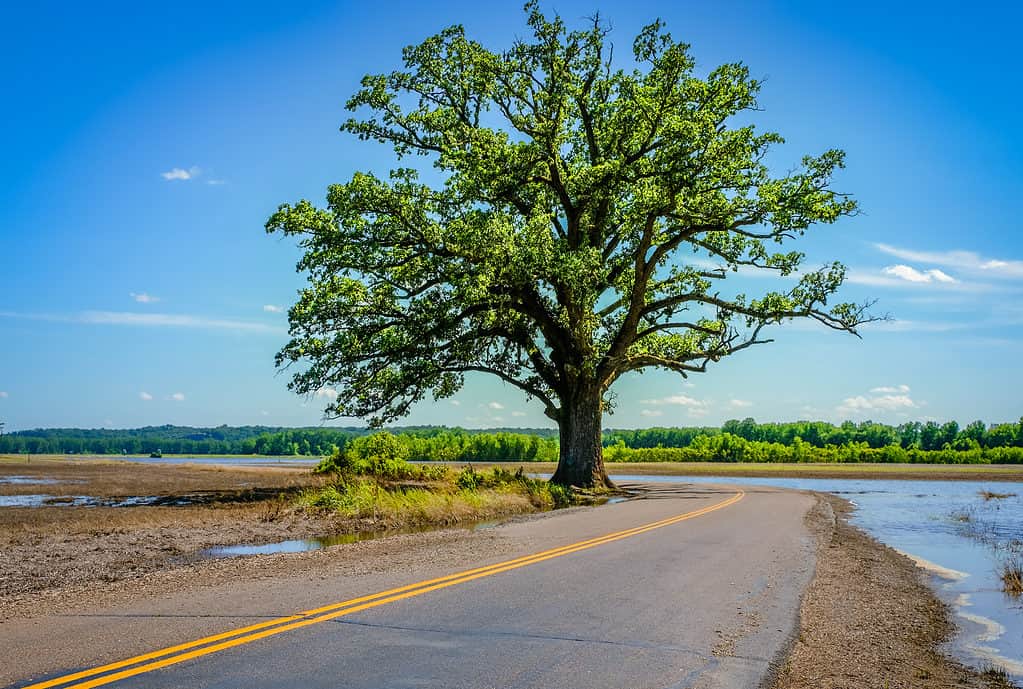
Another Indiana icon, the bur oak is seen throughout the state.
©LanaG/Shutterstock.com
Bur oaks are a common sight across Indiana, making their presence known in almost every county. It is a vast deciduous tree characterized by its expansive, open canopy. Its leaves, which are dark green and sport 5-9 distinct lobes, can stretch up to 12 inches and shift to shades of yellow or golden brown come autumn.
When spring arrives, subtle yellow-green catkins emerge alongside the fresh leaves.
This tree relishes in full sunlight and thrives in soils ranging from dry to moderately moist, provided they offer good drainage.
19. Black Willow (Salix nigra)
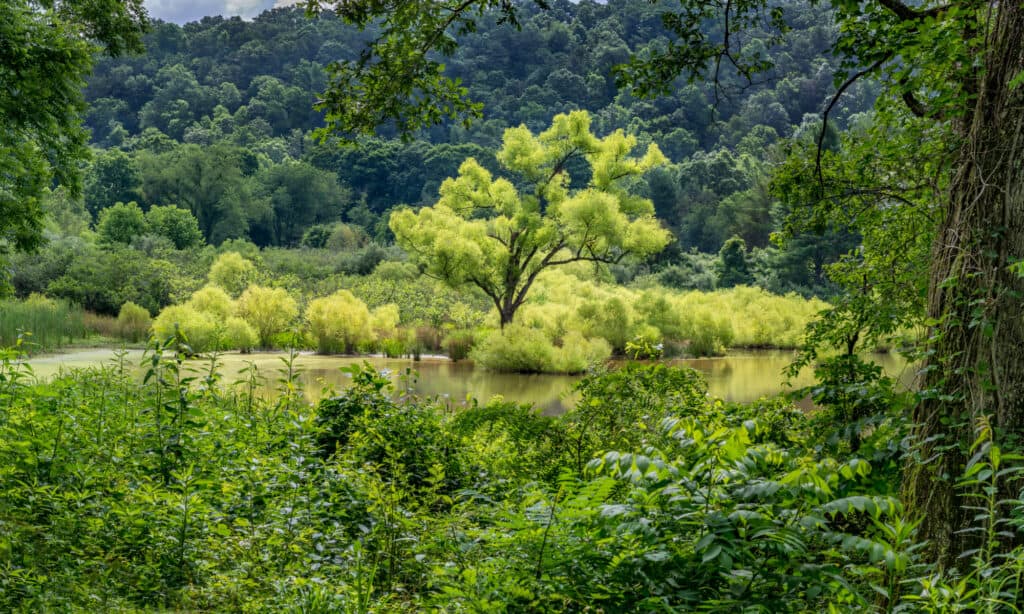
The black willow flourishes in full sun to part shade.
©Gerry Bishop/Shutterstock.com
Growing rapidly, the black willow is a mid-to-large deciduous tree, often showcasing multiple trunks leading up to a beautifully open and rounded canopy with thick limbs.
During the warmer months, it sprouts slender, lance-shaped leaves with finely edged margins, which can reach up to 5 inches in length and point outwards. As autumn approaches, these leaves take on a hint of yellowish-green before they gracefully drop, unveiling the tree’s striking structure.
This tree flourishes in sunlight to partial shade and prefers soil that remains consistently damp.
20. Sassafras (Sassafras albidum)

This tree has unique leaves.
©Katja Schulz / Flickr – License
The sassafras tree, known for its distinctive leaves, has a unique, dense structure that stretches out in layered tiers.
Its leaves, which may resemble a mitten, be ovular, or have three lobes, don a lively green color, stretching up to 7 inches in length. As fall approaches, they transform into striking hues of yellow, orange, and fiery red. During springtime, delicate yellow blossoms make their appearance, either just before or alongside the fresh leaves.
For optimal growth, sassafras trees prefer deep, damp, acidic soils and thrive under the combination of sunlight and partial shade.
21. Staghorn Sumac (Rhus typhina)
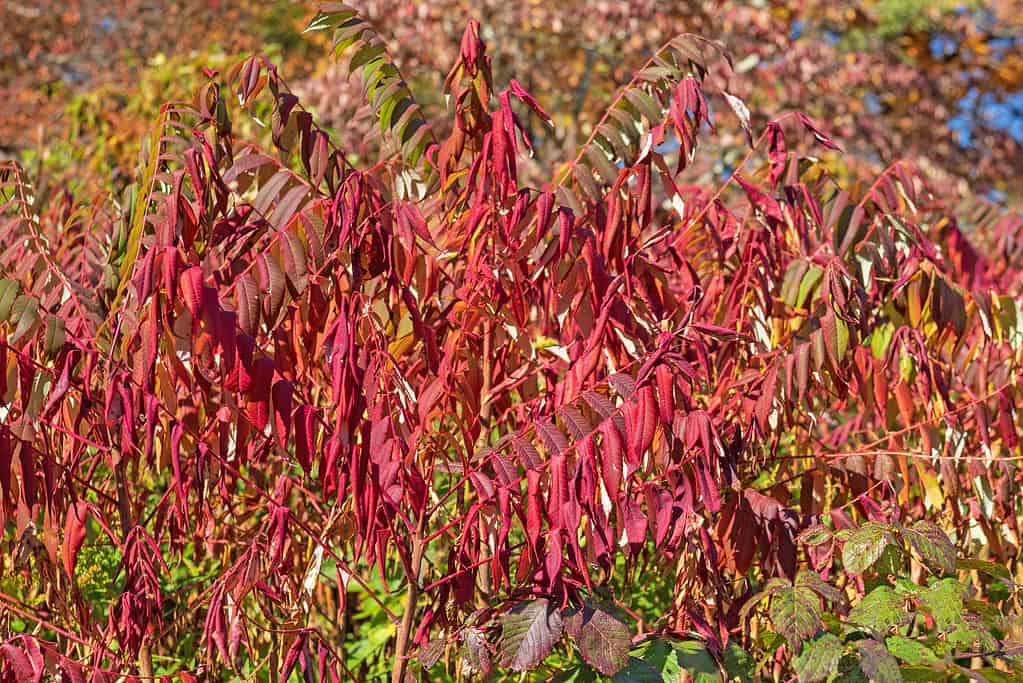
In the fall, the staghorn sumac boasts colorful leaves.
©Wildnerdpix/ via Getty Images
The staghorn sumac is a sought-after tree recognized for its vibrant autumn leaves and eye-catching fruits. This plant, which can grow as a small tree, has a unique branching structure adorned with soft, reddish-brown twigs.
Its expansive, fern-like leaves boast a lively green hue and can reach up to 24 inches in length. As the seasons change, these leaves transition to vivid tones of orange, yellow, and deep red. During the early to mid-summer months, clusters of greenish-yellow flowers emerge.
For the best growth, the staghorn sumac prefers areas with ample sunlight or partial shade and thrives in moderate, well-draining soils.
22. American Witch Hazel (Hamamelis virginiana)
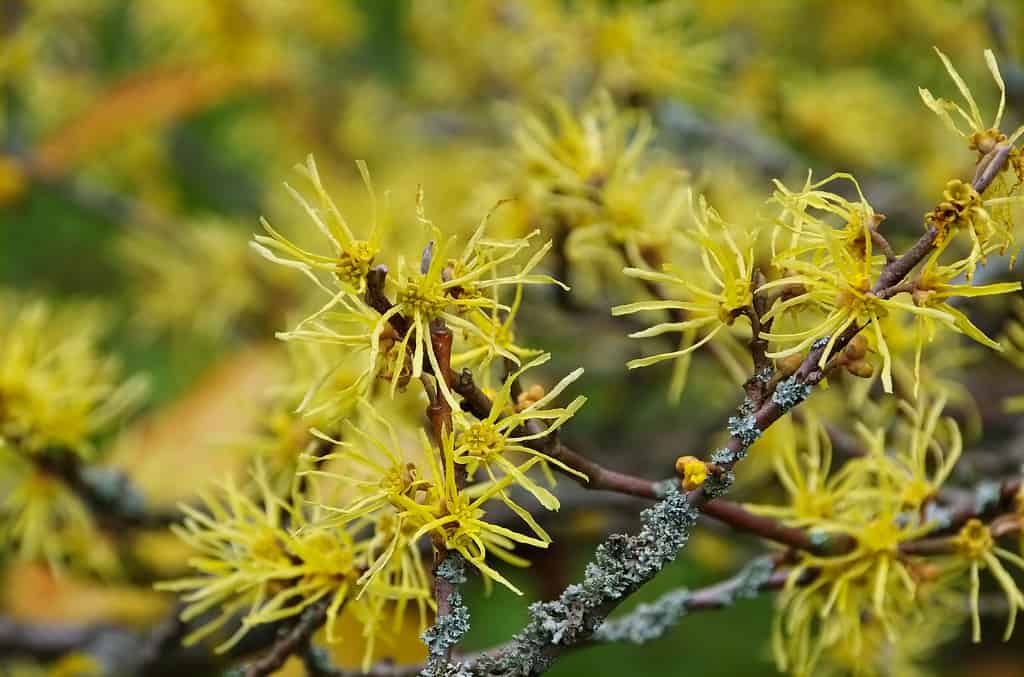
This tree boasts a beautiful fall display.
©LianeM/iStock via Getty Images
The American witch hazel is known for its impressive fall display. It boasts delicately scented pale yellow blooms during the fall and early winter months. These unique flowers feature four ribbon-like, gently curled petals that exude a golden hue.
These blooms unexpectedly grace the plant’s gracefully arching branches and can sometimes remain until December, offering a surprising touch of color in the colder months.
From full sun to complete shade, this tree thrives in moderately moist, well-draining soils.
23. Cucumber Tree (Magnolia acuminata)
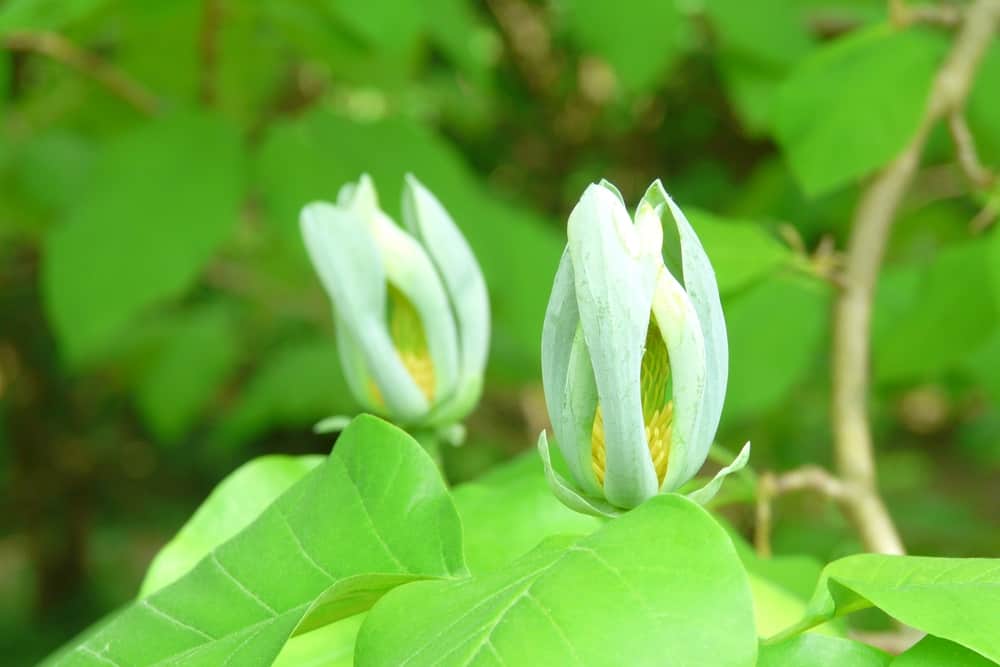
This tree boasts pale yell-green blooms.
©Anna Krzywania/Shutterstock.com
The cucumber tree has a direct stem and a pyramid-like top among the most resilient magnolias.
During the transition from spring to early summer, mature trees (typically those over 12 years old) showcase tulip-like, subtly scented, pale green-yellow blooms that measure 2-4 inches in length. While these flowers are a sight to behold up close, they often go unnoticed since they appear high up on the tree.
This tree flourishes best in sunny to partially shaded areas and thrives in nutrient-rich, slightly acidic, and moist soils that drain well.
Summary of the Most Iconic Trees Native to Indiana
| Tree | Mature Height (Feet) |
|---|---|
| American Plum | 15-30 |
| Bald Cypress | 50-100 |
| American Basswood | 50-110 |
| Black Cherry | 50-100 |
| Black Gum | 50-80 |
| Black Locust | 50-80 |
| Black Oak | 50-100 |
| Black Walnut | 50-100 |
| Eastern Red Cedar | 30-60 |
| Green Ash | 50-100 |
| Kentucky Coffeetree | 50-100 |
| Yellow Buckeye | 50-70 |
| Smooth Alder | 10-20 |
| American Larch | 40-80 |
| Tulip Tree | 60-80 |
| Eastern Cottonwood | 50-80 |
| American Aspen | 20-50 |
| Bur Oak | 60-80 |
| Black Willow | 30-60 |
| Sassafras | 30-60 |
| Staghorn Sumac | 15-25 |
| American Witch Hazel | 15-20 |
| Cucumber Tree | 40-70 |
The photo featured at the top of this post is © PhilAugustavo/iStock via Getty Images
Thank you for reading! Have some feedback for us? Contact the AZ Animals editorial team.






